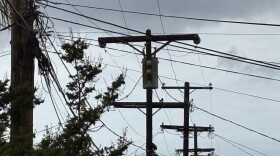San Diego’s wet winters are seen by many as a welcome change from our endless sunny skies. But not everyone looks forward to the storms.
On a recent stormy afternoon Martin Ammerman stood gazing at the large pool of water collecting in the street and lapping at the driveway of his Linda Vista home.
“I hate rain now. I dread it,” he said.
Ammerman’s home sits on top of a San Diego city storm drain. When he and his wife bought their home in 2006 they were told light flooding was a problem when it rained. But they didn’t know the storm drain was clogged, and they never expected the torrents of water that would flood the property during heavy downpours.
Ammerman said major storms sometimes leave up to two feet of water in his backyard and three feet in the crawl space of his home. He described one particularly bad storm in January of last year.
“It was only an inch-and-a-half of rain that day or so. But I think the inch-and-a-half fell in about a two hour period,” he said. “That’s when we had two rows of sandbags across the entire front of the property, which meant the water in the street was probably two to three feet. And it was flowing over the top of the sandbags like white water rapids.”
Turns out the storm drain under Ammerman’s home wasn’t just clogged, it had collapsed. Public records obtained by Ammerman show as of last February there have been nearly 40 calls for service on the storm drain since the year 2000. That doesn’t include the calls for service Ammerman and his wife made to the city during December’s record breaking rains.
As of now, the storm drain pipe is not scheduled to be replaced until spring 2012. A project along those lines would cost the city about $400,000.
“I wake up in the middle of the night running out with our pump, trying to find my jacket and shoes and what not. It’s always in December or January when it’s a little bit cooler, he said.
During his ordeal, Ammerman was in close contact with the office of then-city council woman Donna Frye. Steve Hadley was Frye’s Chief of Staff. He remembers spending nights in the driving rain trying to get a city pump truck to come clean out the storm drain.
“Bought some boots one night, went out there and quickly filled them up in the backyard,” Hadley said. “The water was much higher than my boots and I didn’t go all the way to the backyard as it sloped down. I mean, it really did have at least a knee-high or thigh-high lake back there.”
Hadley said it was frustrating to not be able to resolve the issue while he was working at city hall. But Ammerman’s situation isn’t unique in a city filled with aging infrastructure.
Bill Harris is with the city’s storm water department. “Oh frustration is a big part of it, absolutely.”
Harris said he understands that malfunctioning storm drains present problems for homeowners and communities. But he said his department is dealing with aging pipes throughout the city, record breaking winter storms that have created emergency situations and a budget that gets smaller every year.
“We have to move forward based on a dispassionate review of emergency needs, a dispassionate review of dollars best spent to avoid emergencies if you will,” Harris said. “And we do that each and every year, and we do it very carefully and we do it systematically.”
When the storm water department was formed three years ago, it had a budget of about $48 million. This year it’s working with a budget of $35 million. Harris said there have been cases similar to Ammerman’s on the department’s fix-it list for years. But the issues don’t pose enough of a problem to enough people to get priority. And all it takes is one major storm system, like the one San Diego saw in December, to bump all those smaller projects back down to the bottom of the list.
“They are a problem and they represent a problem for the community. But they don’t present an eminent risk of failure or threat, if you will,” Harris said.
The city estimates expenses related to the December rain storms that flooded Mission Valley and opened up pot holes and sink holes around San Diego to amount to $3 million to $6 million. San Diego may declare a state of emergency, which would let it apply for state and federal aide.
As for Martin Ammerman, he’s filed several claims against the city for damages and expense he’s incurred dealing with the overflowing storm drain in front of his house. And he said he’s looking forward to the drain getting fixed in 2012. “However, we still have to make it through two rainy seasons before then.”
And that’s only if his case doesn’t get bumped back down the list.






